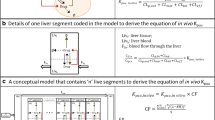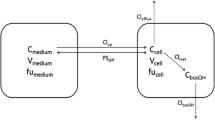Abstract
Previous data on salicylamide (SAM) metabolism in the perfused rat liver had indicated that SAM was metabolized by three parallel (competing) pathways: sulfation, glucuronidation, and hydroxylation, whereas sequential metabolism of the hydroxylated metabolite, gentisamide (GAM), was solely via 5-glucuronidation to form GAM-5G. However, under comparable conditions, preformed GAM formed mainly two monosulfate conjugates at the 2- and 5-positions (GAM-2S and GAM-5S); 5-glucuronidation was a minor pathway. In the present study, the techniques of normal (N) and retrograde (R) rat liver perfusion with SAM and mathematic modeling on SAM and GAM metabolism were used to explore the role of enzymic distributions in determining the dissimilar fates of GAM, as a generated metabolite of SAM or as preformed GAM. Changes in the steady-state extraction ratio of SAM (E) and metabolite formation ratios between N and R perfusions were used as indices of the uneven distribution of enzyme activities. Two SAM concentrations (134 and 295 μM) were used for single-pass perfusion: the lower SAM concentration exceeded the apparent Km for SAM sulfation but was less than those for SAM glucuronidation and hydroxylation; the higher concentration exceeded the apparent Km 's for SAM sulfation and glucuronidation but was less than the Km for hydroxylation. Simulation of SAM metabolism data was carried out with various enzyme distribution patterns and extended to include GAM metabolism. At both input concentrations, E washigh (0.94 at 134 μMand 0.7 at 295 μM) and unchanged during N and R, with SAM-sulfate (SAM-S) as the major metabolite and GAM-5G as the only detectable metabolite of GAM. Saturation of SAM sulfation occurred at the higher input SAM concentration as shown by a decrease in Eand a proportionally less increase in sulfation rates and proportionally more than expected increases in SAM hydroxylation and glucuronidation rates. At both SAM concentrations, the steady-state ratio of metabolite formation rates for SAM-S/SAM-G decreased when flow direction changed from N to R. An insignificant decrease in SAM-S/SAM-OH was observed at the low input SAM concentration, due to the small amount of SAM-OH formed and hence large variation in the ratio among the preparations, whereas at the high input SAM concentration, the decrease in SAM-S/SAM-OH with a change in flow direction from N to R was evident. The metabolite formation ratio, SAM-G/SAM-OH, however, was unchanged at both input concentrations and flow directions. The observed data suggest an anterior SAM sulfation system in relation to the glucuronidation and hydroxylation systems, which are distributed similarly. When the observations were compared to predictions from the enzyme-distributed models, the best prediction on SAM metabolism was given by a model which described sulfation activities anteriorly, glucuronidation activities evenly, and hydroxylation activities posteriorly (perivenous). When the model was used to predict data for SAM and GAM metabolism in once-through perfused rat livers at different input SAM concentrations, in the absence or presence of the sulfation inhibitor, 2,6-dichloro-4-nitrophenol (DCNP), the predictions were in close agreement with previously observed SAM data but failed to predict the exclusive formation of GAM-SG; rather, GAM-2S and GAM-5S were predicted as major sequential metabolites of SAM. The poor correlation for GAM metabolic data may be explained on the basis of subcellular enzyme localizations: the cytochromes P-450 and UDP-glucuronyltransferases, being membrane-bound enzymes, are more coupled for GAM formation and glucuronidation, when GAM was generated intracellularly. The present study suggests that subcompartmentalization of enzymes may need to be considered in hepatic modeling for better prediction of metabolic events.
Similar content being viewed by others
References
K. S. Pang, X. Xu, M. E. Morris, and V. Yuen. Kinetic modeling of conjugations in liver.Fed. Proc. 46:2439–2441 (1987).
M. E. Morris and K. S. Pang. Competition between two enzymes for substrate removal in liver: Modulating effects due to substrate recruitment of hepatocyte activity.J. Pharmacokin. Biopharm. 15:473–496 (1987).
K. S. Pang, H. Koster, I. C. M. Halsema, E. Scholtens, G. J. Mulder, and R. N. Stillwell. Normal and retrograde perfusion to probe the zonal distribution of sulfation and glucuronidation activities of harmol in the perfused rat liver preparation.J. Pharmacol. Exp. Ther. 224:647–653 (1983).
J. R. Dawson, J. G. Weitering, G. J. Mulder, R. N. Stillwell, and K. S. Pang. Alteration of transit time and direction of flow to probe the heterogeneous distribution of conjugating activities for harmol in the perfused rat liver preparation.J Pharmacol. Exp. Ther. 234:691–697 (1985).
M. E. Morris, V. Yuen, and K. S. Pang. Competing pathways in drug metabolism. II. An identical, anterior enzymic distribution for 2- and 5-sulfoconjugation and a posterior localization for 5-glucuronidation of gentisamide in the rat liver.J. Pharmacokin. Biopharm. 16:633–656 (1988).
M. E. Morris, V. Yuen, B. K. Tang, and K. S. Pang. Competing pathways in drug metabolism. I. Effect of input concentration on the conjugation of gentisamide in the once-throughin situ perfused rat liver preparation.J. Pharmacol. Exp. Ther. 245:614–624 (1988).
J. G. Conway, F. C. Kauffman, S. Ji, and R. G. Thurman. Rates of sulfation and glucuronidation of 7-hydroxycoumarin in periportal and pericentral regions of the liver lobule.Mol. Pharmacol. 22:509–516 (1982).
J. G. Conway, F. C. Kauffman, T. Tsukuda, and R. G. Thurman. Glucuronidation of 7-hydroxycoumarin in periportal and pericentral regions of the lobule in livers from untreated and 3-methylcholanthrene-treated rats.Mol. Pharmacol. 33:111–119 (1988).
S. Orrenius, B. Andersson, B. Jernstrom, and P. Moldéus. Isolated hepatocytes as an experimental tool in the study of drug conjugation reactions. In A. Aitio (ed.),Conjugation Reactions in Drug Biotransformation, Elsevier, Amsterdam, 1978, pp. 273–282.
M. Koike, K. Sugeno, and M. Hirata. Sulfoconjugatijon and glucuronidation of salicylamide in isolated rat hepatocytes.J. Pharm. Sci. 70:308–311 (1981).
K. S. Pang, P. Kong, J. A. Terrell, and R. E. Billings. Metabolism of acetaminophen and phenacetin by isolated rat hepatocytes. A system in which the spatial organization inherent in the liver is disrupted.Drug Metab. Dispos. 13:42–50 (1985).
K. S. Pang and R. N. Stillwell. An understanding of the role of enzymic localization of the liver on metabolite kinetics: A computer simulation.J. Pharmacokin. Biopharm. 11:451–468 (1983).
K. S. Pang. The effects of intercellular distribution of drug metabolizing enzymes on the kinetics of stable metabolite formation and elimination by liver: First-pass effects.Drug Metab. Rev. 14:61–76 (1983).
K. S. Pang and J. R. Gillette. Kinetics of metabolite formation and elimination in the perfused rat liver preparation: Differences between the elimination of preformed acetaminophen and acetaminophen formed from phenacetin.J. Pharmacol. Exp. Ther. 207:178–194 (1978).
K. S. Pang and J. A. Terrell. Retrograde perfusion to probe the heterogeneous distribution of hepatic drug metabolizing enzymes in rats.J. Pharmacol. Exp. Ther. 216:339–346 (1981).
K. S. Pang, W. F. Cherry, J. Accaputo, A. J. Schwab, and C. A. Goresky. Combined hepatic arterial-portal venous or hepatic venous flows once-through thein situ perfused rat liver to probe the abundance of drug metabolizing activities. Perihepatic venous O-deethylation activity for phenacetin and periportal sulfation activity for acetaminophen.J. Pharmacol. Exp. Ther. 247:690–700 (1988).
X. Xu, B. K. Tang, and K. S. Pang. Sequential metabolism of salicylamide exclusively to gentisamide-5-glucuronide and not gentisamide sulfate conjugates in the single-pass perfused rat liver.J Pharmacol. Exp. Ther. (under revision).
X. Xu and K. S. Pang. Gentisamide metabolism in perfused rat liver preparation: As a generated metabolite of salicylamide and as a preformed metabolite.Pharmacologist 28:Abstr. No. 157 (1986).
X. Xu and K. S. Pang. On the estimation of enzymatic parameters with nonlinear protein binding and heterogeneity of drug metabolizing enzymes.J. Pharmacokin. Biopharm. (submitted).
H. G. Mandel, V. V. Rodwell, and P. K. Smith. A study of the metabolism of C14 salicylamide in the human.J. Pharmacol. Exp. Ther. 106:433–439 (1952).
X. Xu and K. S. Pang. High-performance liquid Chromatographic method for the quantitation of salicylamide and its metabolites in biological fluids.J. Chromatogr. 420:313–327 (1987).
J. R. deBaun, J. Y. R. Smith, E. C. Miller, and J. A. Miller. Reactivityin vivo of the carcinogen N-hydroxy-2-acetylaminofluorene: Increase by sulfate ion.Science 167:184–186 (1970).
J. H. N. Meerman and G. J. Mulder. Prevention of the hepatotoxic action of N-hydroxy-2-acetylaminofluorene in the rat by inhibition of N-O-sulfation by pentachlorophenol.Life Sci. 28:2361–2365 (1981).
D. Ullrich, G. Fischer, N. Katz, and K. W. Bock. Intralobular distribution of UDP-glucuronosyltransferase in livers from untreated, 3-methylcholanthrene and phenobarbitaltreated rats.Chem. Biol. Interact. 48:181–190 (1984).
J. R. Chowdhury, P. M. Novikoff, N. R. Chowdhury, and A. B. Novikoff. Distribution of UDP-glucuronosyltransferase in rat liver.Proc. Natl. Acad. Sci. USA 82:2990–2994 (1985).
L. W. Wattenberg and J. L. Leong. Histochemical demonstration of reduced pyridine nucleotide dependent polycyclic hydrocarbon metabolizing systems.J. Histochem. Cytochem. 10:412–420 (1962).
S. A. Belinsky, F. C. Kauffman, and R. G. Thurman. Reducing equivalents for mixed function in periportal and pericentral regions of the liver lobule in perfused livers from normal and phenobarbital-treated rats.Mol. Pharmacol. 26:574–581 (1984).
K. S. Pang, J. A. Terrell, S. D. Nelson, K. F. Feuer, M.-J. Clements, and L. Endrenyi. An enzyme-distributed system for lidocaine metabolism in perfused rat liver preparation.J. Pharmacokin. Biopharm. 14:107–130 (1986).
J. Baron, J. A. Redick, and F. P. Guengerich. Immunohistochemical localizations of cytochrome P-450 in the rat liver.Life Sci. 23:2627–2632 (1978).
J. Baron, J. A. Redick, and F. P. Guengerich. An immunohistochemical study on the localizations and distributions of phenobarbital- and 3-methylcholantrene-inducible cytochrome P-450 within the livers of untreated rats.J. Biol. Chem. 256:5931–5937 (1981).
P. E. Gooding, J. Chayen, B. Sawyer, and T. F. Slater. Cytochrome P-450 distribution in rat liver and the effect of sodium phenobarbitone administration.Chem.-Biol. Interact. 20:299–310 (1978).
J. W. DePierre and G. Dallner. Structural aspects of the membrane of the endoplasmic reticulum.Biochim. Biophys. Acta 415:411–472 (1975).
J. W. DePierre, G. Andersson, and G. Dallner. Endoplasmic reticulum and golgi complex. In I. M. Arias (ed.),The Liver: Biology and Pathobiology, Raven Press, New York, 1988, pp. 165–187.
Author information
Authors and Affiliations
Rights and permissions
About this article
Cite this article
Xu, X., Pang, K.S. Hepatic modeling of metabolite kinetics in sequential and parallel pathways: Salicylamide and gentisamide metabolism in perfused rat liver. Journal of Pharmacokinetics and Biopharmaceutics 17, 645–671 (1989). https://doi.org/10.1007/BF01062123
Received:
Revised:
Published:
Issue Date:
DOI: https://doi.org/10.1007/BF01062123




